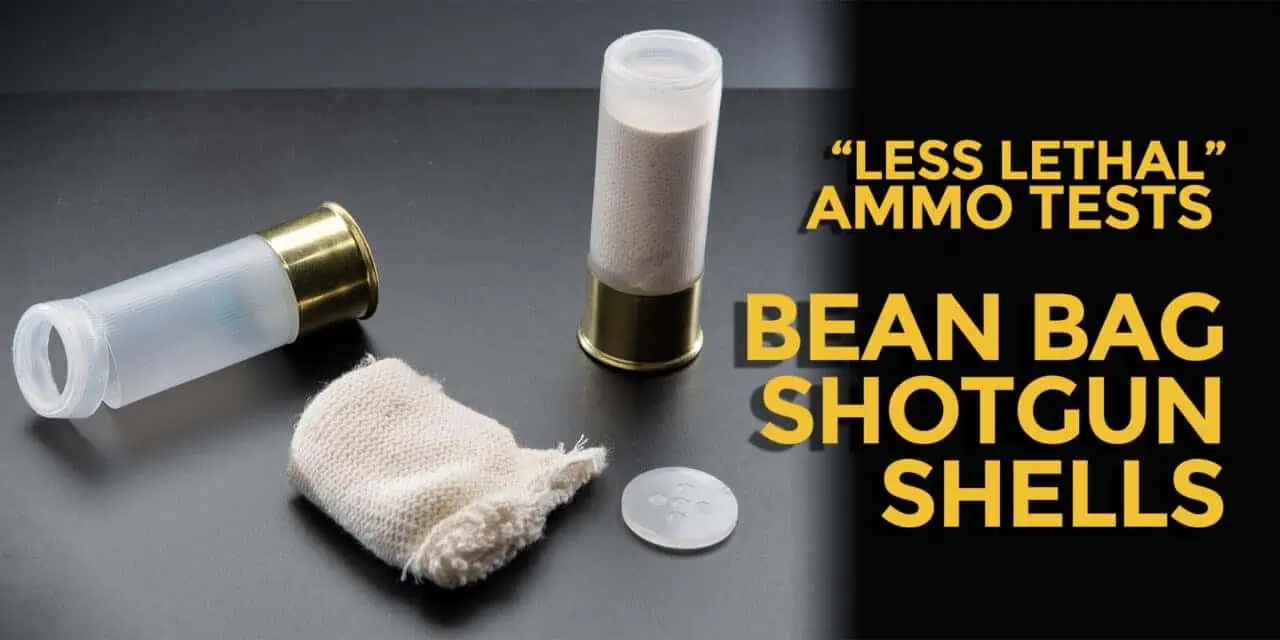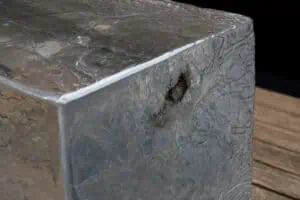Putting Bean Bag Shotgun Rounds To The Test
There are plenty of times when law enforcement finds itself in a tricky situation. They have a suspect who is broadcasting to the world that they mean to do violence, without the direct, imminent threat of lethal force. Maybe it’s an angry man, armed with a knife who’s behind a car, or a similar threat where approaching the suspect to make an arrest would seriously jeopardize the health of the officer.
It’s these types of situations where a shotgun bean bag round comes into play. Rather than fill up a shotshell with lead pellets that spray out when fired, or encase a big chunk of lead in a shell like a deer slug, a shotgun bean bag round is a soft cloth bag filled with lead shot. The bag fires out of the shotgun, flies through the air and the flattens out when it hits the target. Instead of penetrating into the target, and causing tissue damage or blood loss that might result in death, a bean bag round is designed to deliver a sharp, forceful blow to the target.
Origins Of The Shotgun Bean Bag Round
The bean bag shotgun round is another round with its origins during The Troubles in Northern Ireland. Like other types of “less lethal” shotgun ammo, it is not designed to penetrate into a target and cause lethal damage. Rather, the primary purpose of a bean bag round is to deliver damage to the target that stops short of lethal force. A bean bag round has a larger surface area than a lead deer slug. Therefore, it penetrates significantly less than a heavier, faster deer slug.
We’ll test each round by shooting at a block of Clear Ballistics gel from a distance of 15 feet, using a police-surplus Mossberg 500 pump-action shotgun. We’ll be conducting an industry-standard ammo penetration test to determine what a bean bag shotgun round does when it hits a target. One round will be shot at the gel with four layers of heavy cloth in front of it to simulate heavy clothing. The second round will be shot at just the gel to simulate bare skin. For conventional ammo, the FBI recommends a minimum of 12-inches of penetration. However, we are looking for any penetration at all, as that means wounding and other bad stuff is happening on the target.
The rounds we’ll be testing are the “Iron Fist” 12 gauge shotgun bean bag round from Firequest.com. It consists of a shotgun shell with a fibrous disk at one end to push the contents out of the muzzle, a small cloth bag filled with lead shot and a clear plastic cap at the other end to keep everything in-place until fired.
What’s Inside A Bean Bag Shotgun Round
The bean bag itself is approximately 1 ¾ of an inch long, 1 ¼ inches wide and ½ inch tall. The bean bag weighs 1.36 ounces flew downrange at 284 fps when shot from our Mossberg 500 and developed 107 foot/pounds of energy at the muzzle. By way of comparison, a reduced recoil 12 gauge deer slug from Fiocchi weighs 0.875 ounces, with a muzzle velocity of 793 fps and a muzzle energy of 532 foot/pounds.
Quite the difference.
As a comparison, an official major league baseball weighs 5.25 ounces. Thrown at 99 miles per hour, that turns out to be 145 feet per second, which comes out to 107 foot pounds of energy. In other words, at 15 feet, the bean bag round we used is like taking a major league fastball right to the chest. Ouchie.
The low velocity and energy of the bean bag round, combined with the flat and flexible shape of the round itself meant that neither round penetrated into the ballistics gel. Both the rounds bounced off the target quite vigorously, moving the 17 pound block gel several inches back on the table. That level of impact was quite dramatic. The bean bag rounds moved the gel more than either the rubber shotgun slugs or the rock salt rounds we previously tested.
As far as penetration into the gel itself, there was no effect on the block that was covered by heavy cloth. However, the round that hit the bare gel left a mark where the gunpowder residue on the round rubbed off onto the gel.
Not For Use With Every Shotgun
It’s important to note here that all of the less lethal rounds we’ve tested have much lower muzzle energy than most common shotgun ammunition. Because of this, they don’t deliver enough force to cycle the action in a semi-automatic shotgun. These types of rounds should only be used with pump-action shotguns and similar guns where the shooter cycles the action, not the energy of the round itself.
However, while these rounds may be “less lethal,” they are not “non-lethal.” The bean bag rounds we tested did not penetrate, but they can cause massive hemorrhages, concussions and other serious injuries. They are a tool with a specific use by law enforcement, and are at best a novelty round for armed citizens. Armed citizens don’t have to put a suspect in cuffs like law enforcement does. I’m not handing out legal advice here, but we encounter a violent but not deadly threat, it’s in our best interests to either remove ourselves from the danger and call in law enforcement to deal with it. If worse comes to worst, we have other options like pepper spray available to us for use against dangerous, but not quite lethal threats.
Not For Use In Most Situations
Less lethal ammunition such as bean-bag shotgun rounds have their uses, but those uses are primarily for military, law enforcement and other agencies that need to deal with large groups of angry and violent people. They have this often thankless task, and it serves a vital role in today’s society. With a few exceptions such as animal control, bean bag shotgun rounds and other less-lethal ammo should be left to the people who use it to put down a riot. Less lethal ammo may be fun to shoot, but it’s not something that should be found in the average gun owner’s ammo can.




